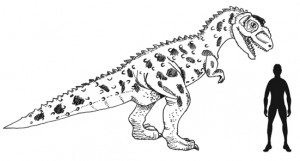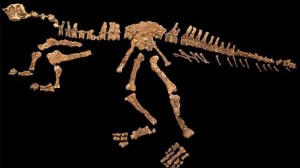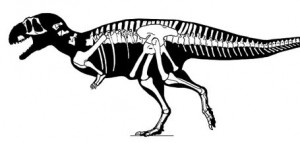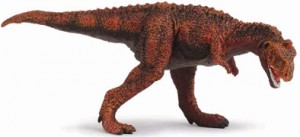New Species of Abelisaurid Described
Eoabelisaurus – Ancient Abelisaurid but with Advanced Anatomical Characteristics
A team of scientists from the Edigio Feruglio Museum of Palaeontology in Chubut (southern Argentina), have unveiled the near complete fossil skeleton of a Jurassic-aged abelisaurid theropod dinosaur. A new abelisaurid dinosaur species has been described. The fossils of this fearsome, meat-eating dinosaur were discovered in Middle Jurassic aged strata.
Basal abelisaurids are known from the Jurassic, but most of the fossils found of this type of predator in South America, are associated with much younger rocks laid down towards the end of the Cretaceous some ninety million years after this new dinosaur genus roamed what was to become Argentina. The fossils reveal that this ancient creature, a dinosaur that lived before iconic dinosaurs of the Jurassic such as Brachiosaurus, Diplodocus and Allosaurus evolved, had a number of anatomical features associated with the last of the abelisaurs, creatures that roamed the Earth at the very end of the Cretaceous geological period.
New Abelisaurid Dinosaur Species
The abelisaurs are a very distinctive group of meat-eating dinosaurs, known almost exclusively from fossils found in the Southern Hemisphere. Palaeontologists believe that they evolved from a primitive line of theropod dinosaurs known as the ceratosaurids. It seems that towards the end of the Cretaceous, whilst the tyrannosaurs became the dominant, apex predator in northern latitudes, in the south, the top predators were the abelisaurids.
An Illustration of a Typical Abelisaur (Rugops primus)
Picture credit: Everything Dinosaur
Abelisaurids are noted for their deep, blunt but narrow skulls, the top of which were often adorned with crests or horns. These bipeds had large pelvises and very tiny, much reduced, stubby arms with four fingered hands. A number of abelisaur fossils have been found mainly in India, Madagascar and South America. Scientists have speculated that more primitive members of this group, earlier forms, referred to as basal abelisaurids, probably had longer arms, similar in proportion to their ceratosaur ancestors, but this new specimen, scientifically named as Eoabelisaurus mefi (Early Abel’s Lizard), although dating from 170-million-year-old strata, it too has the tiny arms of its relatives that lived much later in the Age of Dinosaurs.
Abelisaurs
As a group, the abelisaurs were virtually unknown until the mid-1980s when scientists exploring the geology of South America discovered the skull of a new type of huge, meat-eating dinosaur. Argentinean palaeontologists Jose Bonaparte and Fernando Novas were responsible for the scientific study of this specimen and they named this new dinosaur Abelisaurus (A. comahuensis), the name honours Roberto Abel, the director of the Argentinean Museum of Natural Sciences at the time.
A paper describing this new dinosaur genus has been published in the leading London-based, scientific journal “the Proceedings of the Royal Society”.
The animal has been described as a scaled-down version of Tyrannosaurus rex, another dinosaur known for its tiny, stunted arms. However, the tyrannosaurs and the abelisaurids were not closely related. The forelimbs of these two types of predatory dinosaur may have been similar, but the resemblance was only superficial.
In tyrannosaurs, the bones of the lower arm (the ulna and radius), were smaller than the bone found in the upper arm (the humerus), but they were still substantial bones, the hand had two functional fingers (first and second digits), tyrannosaurs being descended from meat-eating dinosaurs that had three-fingered hands. In later abelisaurids, the ulna and the radius were very much smaller than in similar sized tyrannosaurs, these bones in abelisaurs were little bigger than some of the bones that made up the wrist portion of the forelimb.
The Fossil Material Ascribed to the new Abelisaur Genus (Eoabelisaurus mefi)
Picture credit: AFP
Remarkable Fossil Discovery
This fossil discovery, is remarkable for two reasons. Firstly, the fossils found make up an almost complete specimen, finding such a near complete specimen of a dinosaur, especially a theropod is exceptionally rare. Secondly, this discovery helps confirm that primitive albelisaurs, albeit with some advanced anatomical features such as the reduced arms, were present in the Middle Jurassic.
This new species E. mefi, is one of the earliest known members of this group, and it predates most of the other Argentinean abelisaur material by tens of millions of years. The only other basal abelisaurid known from this part of the Jurassic, is a species known as Berberosaurus liassicus, fossils of which were found in Morocco.
Scientists have estimated that this new South American dinosaur would have been at least six metres long, not the largest abelisaurid known to science; but a sizeable beast none the less, and probably the apex predator in the region during this part of the Jurassic geological period. It is difficult to estimate the weight of such a creature, but the robust femur (thigh bone) and strong looking legs give an indication that this dinosaur could have weighed more than one tonne.
A spokes person for the scientists responsible for producing the academic paper on this creature stated that unlike other types of abelisaurid from the Early Cretaceous, Eoabelisaurus mefi had completely reduced arms and tiny claws. The arm bones resemble those associated with much later types of abelisaurid, fearsome creatures such as Rajasaurus (India), Majungasaurus from Madagascar and Carnotaurus (also from Southern Argentina). The fossils of these abelisaurids date from at least seventy million years ago, a time towards the end of the Age of Dinosaurs, at the very end of the Cretaceous.
An Illustration of Eoabelisaurus mefi
Picture credit: AFP/Pol and Rauhut.
The reduced arms in this Middoe Jurassic dinosaur may be an example of convergent evolution, where two organisms evolve the same adaptations but are not necessarily that closely related. For example, Eoabelisaurus could have evolved the same hunting technique and style of biting of its much later abelisaurid cousins such as Carnotaurus and Rajasaurus. The arms being so small, would have been virtually vestigial and unable to grasp and hold prey. It is likely that these types of dinosaurs evolved a technique of hunting that only required the use of their teeth.
The fossil evidence suggests that these dinosaurs had very powerful bites and strong, sharp teeth that would have made them very effective hunters of other large dinosaurs that shared their habitat.
The first fossilised remains of this dinosaur, consisting of part of the skull and backbone were found by a scientific expedition back in 2009, but as the weather closed in, the dig site, at a location known as Condor Hill, had to be abandoned until the following year. Once the fossil material had been carefully excavated from the site, it was transported in large plaster-jacketed blocks for further preparation at the Edigio Feruglio Museum of Palaeontology in Chubut Province. Palaeontologists hope that the near complete and articulated dinosaur fossils will form part of a new exhibition which will highlight the evolution of theropod dinosaurs in Argentina.
An Illustration of the Abelisaurid Majungatholus (Majungasaurus)
Picture credit: Everything Dinosaur
To view replicas of abelisaurids and other theropod dinosaurs: Abelisaurids, Theropods and Other Dinosaur Models (CollectA Prehistoric Life Models).





